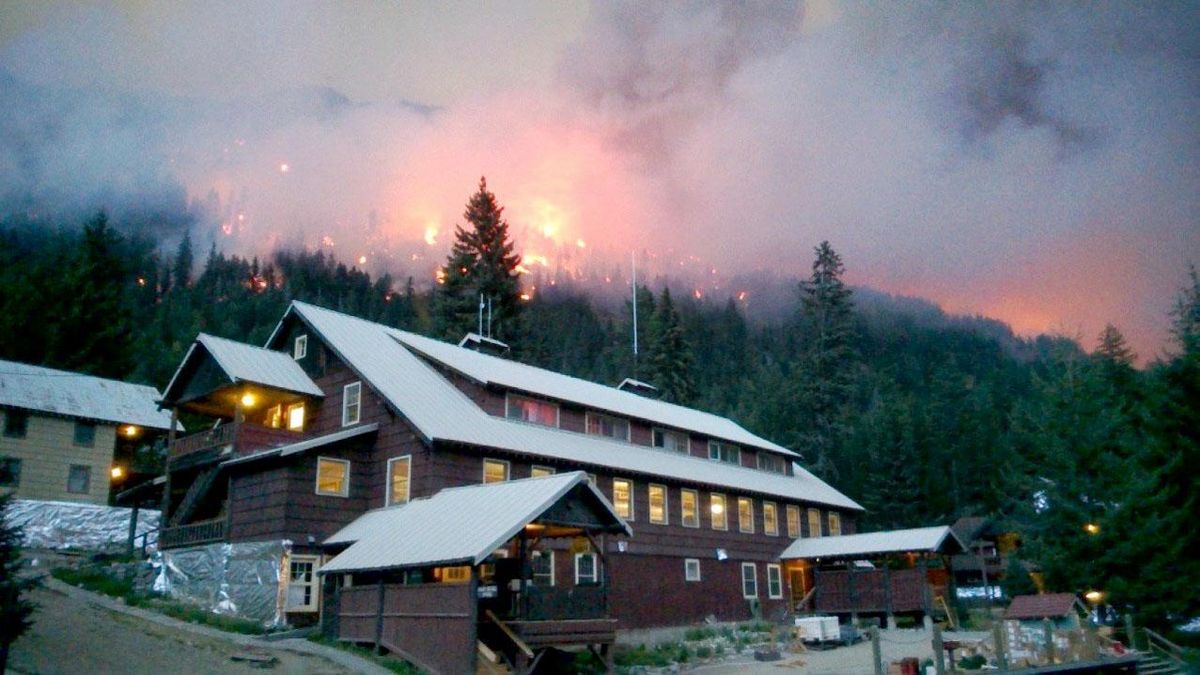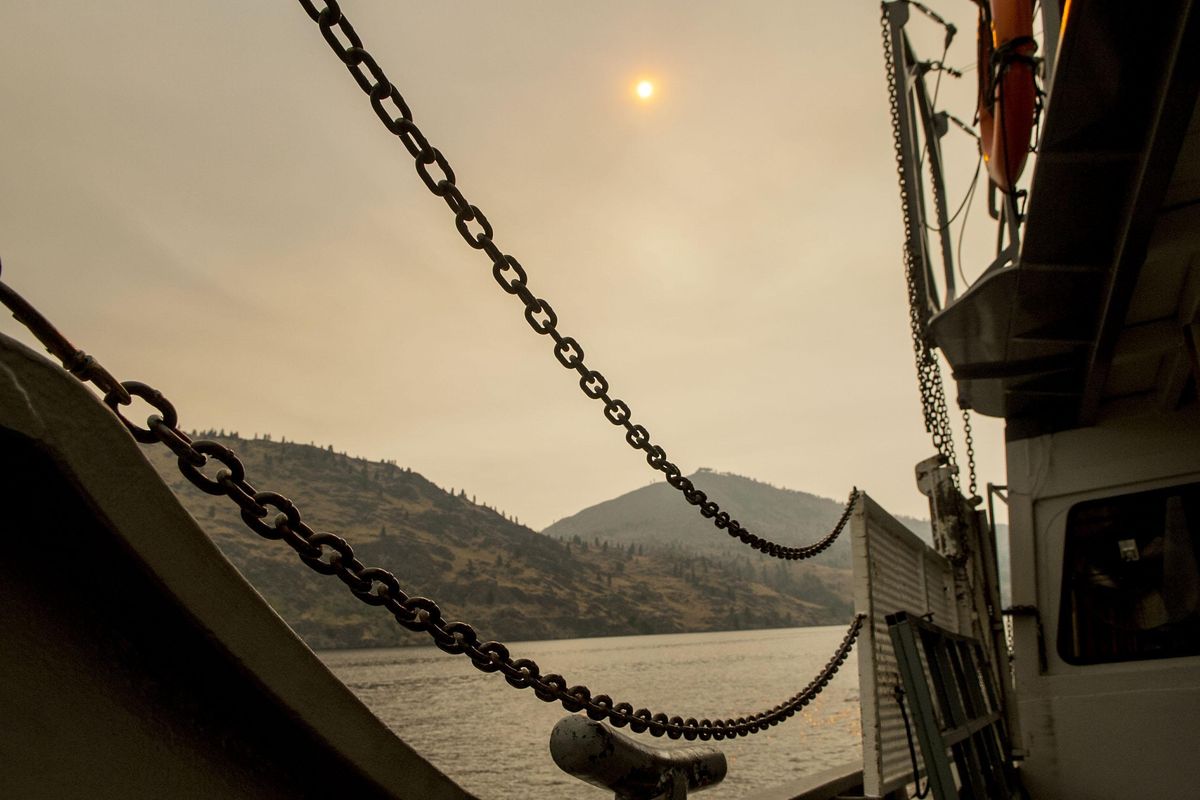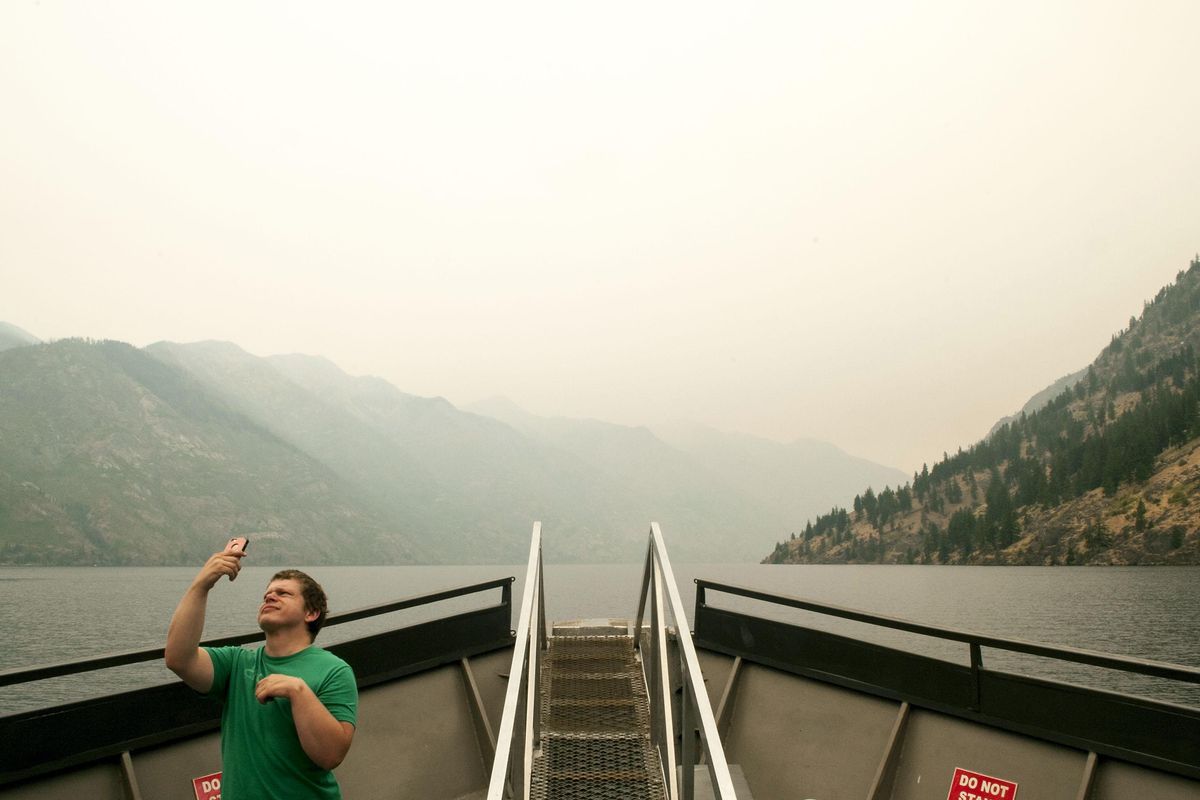Holden Village finds new beginning after test of fire, massive mine cleanup
The Lady of the Lake takes off from Field's Point on Lake Chelan bound for Holden Village. (Kathy Plonka / The Spokesman-Review)
LAKE CHELAN, Wash. – As wildfires burned toward Holden Village, a religious retreat center at the edge of the North Cascades wilderness, Lutherans dropped to their knees and prayed.
Much of the West was on fire during the summer of 2015. People lost homes in Washington, Oregon and California as wildfires consumed a record 10.1 million acres.
But as the Wolverine fire morphed from a small, lightning-caused smolder to a fast-moving blaze, thousands of people across the country were fixated on the fate of a cluster of historic wooden buildings in its path.
Holden Village attracts about 4,000 guests each summer. They make a pilgrimage of sorts to the former mining town near the Glacier Peak Wilderness. The rustic retreat is a place to spend unplugged time with family and friends, hike into the alpine wilderness and ponder deep questions of life and faith.
That Holden Village survived the 70,000-acre Wolverine fire of 2015 seems miraculous to some.
“This place is only here by God’s grace,” said the Rev. Terry Frovik, a Minnesota pastor who’s been making periodic treks to Holden since the 1970s.
Three things came together that helped save Holden Village, said Jeff Pierce, Holden’s longtime fire marshal.
A $570 million mine cleanup led to the installation of a powerful sprinkler system in the village. The sprinklers created a “dome of humidity” around Holden during the fire, which allowed hotshot crews to set controlled burns, creating a firebreak that protected the village.
“Maybe it’s a coincidence,” Pierce, a 30-year firefighter, said of the timing of events. “But divine intervention comes to mind. The lightning strike didn’t occur until a month after the sprinklers were installed.”
A company town for miners
Holden Village owes its existence to mining.
In the 1930s, Howe Sound Mining Co. opened a copper mine in the North Cascades. To provide housing for workers, the company built a town with a school, barbershop and a recreation hall with a bowling alley.
About 600 people lived at Holden Village until 1957, when the price of copper dropped and the mine closed. Howe Sound tried to sell Holden Village for $100,000, advertising the property as a prospective mountain resort.
When no buyer emerged, the company donated the property to Lutheran Bible Institute in Seattle for a church camp. Holden Village eventually incorporated as a nonprofit, with ties to the Evangelical Lutheran Church in America.
The village was a spectacular but polluted gift. For $1, the Lutherans acquired a wilderness retreat and 9 million tons of toxic mine tailings.
Since Holden Village opened as a retreat center in the 1960s, generations of families have formed
Holden’s remoteness is part of its draw. The village has no cell service. Getting there requires a two-hour ferry ride on Lake Chelan and an 11-mile bus ride up a bumpy gravel road.
Many of the camp’s visitors come from the Midwest.
“There have been trainloads of people coming through Spokane and into Wenatchee to catch the boat to Holden Village,” said the Rev. Martin Wells, a retired Lutheran bishop for Eastern Washington and Idaho who was a co-director at Holden during the 1990s. “People have a deep loyalty and affection for this place.”
Amid the pristine beauty of the Okanogan-Wenatchee National Forest, the rust-colored tailings piles were a reminder of Holden’s industrial past and ongoing pollution problems.
The village prides itself on an eco-friendly existence. A small hydropower plant provides electricity. Guests are encouraged to take short showers, wear sweaters and recycle.
The village’s environmental stewardship clashed with the mine waste, which leached heavy metals into Railroad Creek, a tributary of Lake Chelan. On windy days, dust from the tailings piles blew over the village.
Wells recalled how he once flew over Holden Village in a commercial jet.
“You could see this bright orange patch in the forest,” he said. “It was the tailings piles.”
An expensive pollution problem
For years, the Okanogan-Wenatchee National Forest wrestled with the problem of pollution from the old Holden Mine.
Holden Village operates under a special use permit from the Forest Service. Both parties wanted a cleanup, but Holden Village didn’t have deep pockets to pay for the work. Howe Sound, the mine’s operator, had ceased to exist.
Through the Superfund process, the federal government eventually identified a successor company to Howe Sound Mining, which was responsible for the cleanup costs. The company was Rio Tinto, a multinational Australian-British mining firm.
Holden Village closed to summer guests during the five years of mine remediation. Instead of building a work camp, Rio Tinto rented Holden for its contractors and employees.
To compensate Holden Village for the disruption, Rio Tinto paid the nonprofit a yearly amount equal to twice its annual operating budget. Holden used the money to upgrade its infrastructure.
An outdoor sprinkler system was part of the infrastructure work. Pierce, the fire marshal, had been working on the project for 11 years.
“I like to give Rio Tinto credit for making it possible for us to install the sprinklers,” he said. The “Big Gun” sprinklers were operational just in time.
In late June 2015, lightning started a small fire northeast of Holden Village. It was burning in the Wolverine Creek drainage.
A fast-moving wildfire
Forest Service officials warned Holden’s staff that fire conditions could change rapidly.
By late July, their fears were realized. About 400 people – Rio Tinto’s crew and most of Holden’s staff – were evacuated from the village by bus and left on the ferry. A small operations crew stayed behind. After two days of extreme fire behavior, most of the remaining people were evacuated by helicopter.
Pierce was on Vashon Island near Seattle, dealing with a family emergency, when the fire blew up. When he got back to the Chelan area, the Wolverine fire’s incident commander decided Pierce should return to the village so he could brief fire crews on how the sprinklers worked.
“The only way we’re going to save the village is by putting a ring of black around it,” the fire’s operations chief told Pierce.
As the sprinklers soaked the village, a few key Holden staff members helped two hotshot crews prepare Holden for the wildfire. The crews cut down trees and brush, increasing the size of the clear zone around the village. They wrapped buildings with fire-resistant material to protect them from embers.
“The Wolverine fire was eventually going to arrive at Holden Village,” Pierce said. “They managed how the fire reached the village with an organized plan.”
After several days of preparation, helicopters dropped “fire eggs” into bands of trees on ridges above the village. The ignition occurred in the evening.
That night, the fire on the hillsides glowed like charcoal briquettes. A herd of mule deer crowded into the village, seeking refuge.
The next morning, fire crews started back-burning the areas up to the fire line.
By about 8 p.m., the Wolverine fire had come and gone. Holden Village was still standing.
If the village had burned down, Holden could have rebuilt, Pierce said. But it would have taken years to get approval to rebuild at the edge of a wilderness area, he said.
Wells, the retired bishop, isn’t so sure Holden would have been rebuilt.
“Quite literally, I think it would have been the end of the village,” he said. “The buildings show visitors what a remote mining camp looked and felt like. They’re a unique asset for the history of the Pacific Northwest and mining. … There would be no reason to attempt to replicate them.”
The Forest Service would have tried to save Holden Village with its own sprinklers, if the village’s hadn’t been installed, said Chelan District Ranger Kari Grover Wier. But the agency’s sprinklers weren’t nearly as powerful, she said.
A new beginning
After the five-year closure for the mine remediation, Holden Village reopened to summer guests in June. The theme for the summer programming was “New Beginnings.”
Kids and parents again crowded the village, immersing themselves in the camp experiences: crafts, nature walks and evening devotions. In the mornings, they woke to the sound of water from the sprinklers hitting the buildings’ metal roofs.
Bill and Marilyn Burwell, a central Oregon couple, were eager to return to Holden. During the summer of 2015, they checked Forest Service websites for daily wildfire updates. Their family has a 40-year history of summer visits to Holden, starting when their son was 4.
“We have so many memories here,” Marilyn Burwell said.
Bill Burwell, a retired civil engineer, wanted a firsthand look at the mine remediation. He was pleased with what he saw.
Travis Houle, Holden’s naturalist, led hikes to educate visitors about the mine remediation project. Ninety acres of tailings piles have been resculpted and covered with clean rock. When water seeps through the tailings, it hits an underground wall. The water is collected and sent to a treatment plant where the heavy metals are removed.
As Railroad Creek’s water quality improves, cutthroat trout are appearing in the stream again, Houle said.
Houle likes to intrigue Holden guests with this fact: The Holden Mine generated $66 million in income for Howe Sound, worth about $567 million in today’s dollars. Rio Tinto’s cleanup costs have surpassed that, and the company will be responsible for ongoing water treatment at the site.
Beauty and renewal
In late August, David and Ada Dorn, of Livermore, California, hiked through the burned landscape surrounding Holden Village. Shoulder-high patches of fireweed along the trail released fluffy clouds of seeds.
David Dorn, a retired research physicist, saw beauty and renewal in the blackened forest. The Wolverine fire was the first large wildfire to burn through the area in about 100 years.
Through new gaps in the trees, the couple also had a view of the mine remediation site. The rock piles look stark now, but new plantings of trees and bushes on the site will soften the edges.
“If you walk on this site in 15 years,” Houle said, “you’ll see a forest beginning to grow, not a toxic mine site.”






























